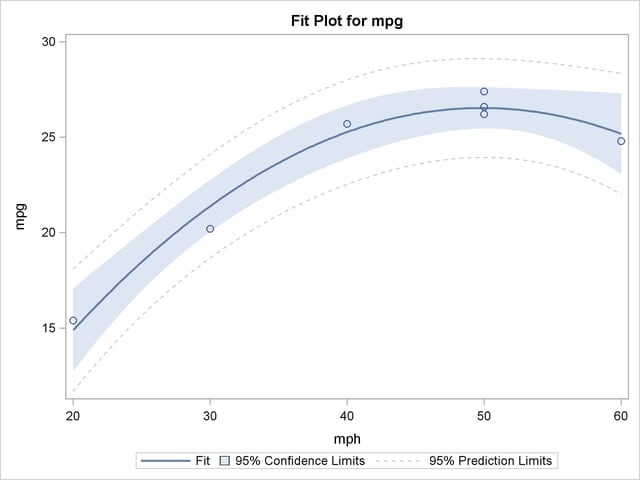| The GLM Procedure |
Example 39.2 Regression with Mileage Data
A car is tested for gas mileage at various speeds to determine at what speed the car achieves the highest gas mileage. A quadratic model is fit to the experimental data. The following statements produce Output 39.2.1 through Output 39.2.4.
title 'Gasoline Mileage Experiment'; data mileage; input mph mpg @@; datalines; 20 15.4 30 20.2 40 25.7 50 26.2 50 26.6 50 27.4 55 . 60 24.8 ;
ods graphics on; proc glm; model mpg=mph mph*mph / p clm; run; ods graphics off;
| Gasoline Mileage Experiment |
| Number of Observations Read | 8 |
|---|---|
| Number of Observations Used | 7 |
| Gasoline Mileage Experiment |
| Source | DF | Sum of Squares | Mean Square | F Value | Pr > F |
|---|---|---|---|---|---|
| Model | 2 | 111.8086183 | 55.9043091 | 77.96 | 0.0006 |
| Error | 4 | 2.8685246 | 0.7171311 | ||
| Corrected Total | 6 | 114.6771429 |
| Source | DF | Type I SS | Mean Square | F Value | Pr > F |
|---|---|---|---|---|---|
| mph | 1 | 85.64464286 | 85.64464286 | 119.43 | 0.0004 |
| mph*mph | 1 | 26.16397541 | 26.16397541 | 36.48 | 0.0038 |
The overall  statistic is significant. The tests of mph and mph*mph in the Type I sums of squares show that both the linear and quadratic terms in the regression model are significant. The model fits well, with an
statistic is significant. The tests of mph and mph*mph in the Type I sums of squares show that both the linear and quadratic terms in the regression model are significant. The model fits well, with an  of 0.97. The table of parameter estimates indicates that the estimated regression equation is
of 0.97. The table of parameter estimates indicates that the estimated regression equation is
 |
 |
 |
| Observation | Observed | Predicted | Residual | 95% Confidence Limits for Mean Predicted Value |
||
|---|---|---|---|---|---|---|
| 1 | 15.40000000 | 14.88032787 | 0.51967213 | 12.69701317 | 17.06364257 | |
| 2 | 20.20000000 | 21.38360656 | -1.18360656 | 20.01727192 | 22.74994119 | |
| 3 | 25.70000000 | 25.26721311 | 0.43278689 | 23.87460041 | 26.65982582 | |
| 4 | 26.20000000 | 26.53114754 | -0.33114754 | 25.44573423 | 27.61656085 | |
| 5 | 26.60000000 | 26.53114754 | 0.06885246 | 25.44573423 | 27.61656085 | |
| 6 | 27.40000000 | 26.53114754 | 0.86885246 | 25.44573423 | 27.61656085 | |
| 7 | * | . | 26.18073770 | . | 24.88679308 | 27.47468233 |
| 8 | 24.80000000 | 25.17540984 | -0.37540984 | 23.05954977 | 27.29126990 | |
The P and CLM options in the MODEL statement produce the table shown in Output 39.2.2. For each observation, the observed, predicted, and residual values are shown. In addition, the 95% confidence limits for a mean predicted value are shown for each observation. Note that the observation with a missing value for mph is not used in the analysis, but predicted and confidence limit values are shown.
The last portion of the output listing, shown in Output 39.2.3, gives some additional information about the residuals. The Press statistic gives the sum of squares of predicted residual errors, as described in
Chapter 4,
Introduction to Regression Procedures.
The First Order Autocorrelation and the Durbin-Watson  statistic, which measures first-order autocorrelation, are also given.
statistic, which measures first-order autocorrelation, are also given.

Finally, the ODS GRAPHICS ON command in the previous statements enables ODS Graphics, which in this case produces the plot shown in Output 39.2.4 of the actual and predicted values for the data, as well as a band representing the confidence limits for individual predictions. The quadratic relationship between mpg and mph is evident.
Copyright © SAS Institute, Inc. All Rights Reserved.